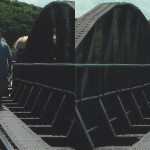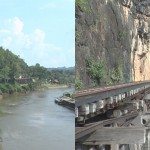
Many times when a new camera comes on the market the elation is often mixed with the feeling of, “if it only had X or Y, then it would be really great.” But when Ken Burgess, the Wizard of 3D sees a new camera his response is a little different. Instead of just saying I wish it had this or that Ken sets out and creates it. Kens design and engineering skills enable him and his trusty 3D printer to make to make accessories for 3D cameras that you and I only dream of.
Ken and his company , Cyclopital3D, created a set of accessories for the Panasonic HDC-Z10000, the Panasonic AG 3DA1 and the Sony TD 300. Since I have the first two cameras Ken was kind enough to send me products to evaluate for this review.
I spoke to Ken and he gave me an overview of the three basic product types that he offers. There are stereo base extenders, which he calls SBE’s. Wide angle lenses, which he calls WAL’s and filter close-up adapters, which he calls FCA’s.
The first camera that will talk about is the Panasonic HDC Z 10,000. Ken offers a WAL and SWAL or super wide angle or fisheye type lens and FCA and a PFA. So what is that all mean? Let’s take a look. Below you see the WAL with the lens shade attached. While the lens on the Z 10,000 is wider than the AG 3DA1 you may still find yourself wanting a wider angle of view. All of Kens adapters come with threaded rings that accept additional filters. The WAL has an 86 mm ring with a 95 mm adapter. This works out fantastic when working outside you can add a neutral density filter which unfortunately Panasonic left off of this camera as a built-in feature. Ken supplied me with an adapter that I have fallen in love with, a slim wide-band fader. This adjustable neutral density filter enables me to dial-in the precise settings that I want to use on any particular shot. Kens lens shade works wonderfully to keep stray light out of your lenses and is wide enough to allow me to work with the adjustable neutral density filter easily. What’s more, it’s much lighter than adding on rails and a mattebox.
The WAL essentially halves the focal length of the camera and can be used at any zoom at a minimum zoom where the zoom indicator shows zero. It creates a 21.5 mm angle of view with an FOV of 80°. Since the camera lenses are at 45 mm, adding the WAL doesn’t create any Z-scale distortion. Although it does create a slight barrel distortion which can be easily fixed using Edius stereo adjuster in post. By using three elements that are well corrected can has minimized the degree of defocusing or chromatic aberrations at the edges. But if you like, you can always crop in a little bit in post or just slightly zoom on your shot. Experiment with it a bit to see what you like best.
My absolute favorite and something I never shoot without now is the FCA. First, just like the WAL. It allows you to add 86 or 95 mm professional filters to the front of your camera. In addition, when the act when you add the FCA or the WAL, you must first remove the standard front cover and plastic lens protector. This is really a good thing since the plastic lens protector scratches easily and can and will degrade the quality of your images if left on. With the FCA, you can add 37 mm UV glass filters. This is a much better solution and gives you good lens protection without pitcher degradation.
The FCA and WAL are attached using a thumbscrew type knob at the top of the unit just noted up when you put the adapter on and loosen it to remove the adapter no tools are required. To add the lens hood there’s a second thumbscrew at the bottom of the adapter which snags up and holds the lens in place very nicely. One note can do offer an SWAL, which gives you a field of view of 160° which I have not been able to try out yet. It might make an interesting action cam alternative giving you a symbol similar view to a Go Pro Hero 3D rig.
The FCA also offers you the ability to add-on close-up filters. Ken supplied me with a very nice Vivitar set of 86 mm +1+2 and +4 diopter close-up adapters. The 86 mm ring on the FCA is used directly for the close-up lenses can said they couldn’t find a source of 95 mm close-up lenses, but discovered that 86 mm work fine as long as they were close enough to the lens, they would not work if the unit had a 95 mm ring step down to 86 because that pushes the close-up lens out to far, but going from 86 to 95 turned out to be no problem. He went on to tell me that the purpose of the close-up lenses twofold. First, it is to allow close focusing but more importantly for 3D the prismatic character of using single lens. Off access and convergence and increases the common scene coverage as you get close to a subject. This technique works great for close-ups or macros as long as a total depth of the scene is limited. It turns out that the red indicator on the Z 10,000 will warn you if there’s too much total depth, even when the close-up lenses used. Quite a nice result really. The range of close-up is really more like macro think just lips or eyes, but not the whole face because the Z space is not reduced the depth range must be small, but under the right conditions the results can be absolutely stunning and not possible to do without the lens.
That brings us to the SBE or the stereo base extender. The 45 mm on the Panasonic AG 3DA1 spacing means that for distance shots your 3D is going to look cardboard and flat. But by increasing your inner axial to 200 mm using the SBE, your distance shots can look fantastic. The best part is that you don’t need to use a beam splitter and two cameras in order to do this. With the SBE, outdoor working distances run from about 3 to 4 m to infinity. The stereo base extender provides a 3X base extension. The reasoning here is that when you zoom in by a factor of three, you increase the size of objects in the frame by a factor of three bringing them bringing them closer in a 2-D sense. Without the SBE, the parallax to the objects is not changed the objects will still appear to be far away as they were. The objects will look too big and rather flat for the scale of the world and the depth of the whole scene will appear compressed, making the objects in the scene look like cardboard cutouts. The reason is that the perceived scale in C does not match the scale in Y and X basically the 3D aspect ratio is wrong. Errors in the X, Y aspect ratio are easily noticeable, and quite objectionable if the error is 20% or more. If you’re Z scale does not match the scale of the X and Y, for instance in the case of people’s heads. They will look like cardboard. Increasing the stereo base by a 3X factor when you zoom in 3X will maintain a correct aspect ratio in 3D space. Fortunately, errors of scale in Z space are not nearly as noticeable as for X and Y. Where 20% is the practical limit and X and Y errors of his much is 200% are tolerable for Z. Of course, you may want to move away from realism and distort the scene in Z, but that’s another subject, one to do with creativity. The bottom line is that the SBE restores depth when you zoom. You will notice in fact that the SBE cannot be used with a short focal length because there’s vignetting with focal length shorter than about 60 on the zoom indicator.
I have tested each of these and found the results to be superb. I’d be very interested to get hands-on with the TD300 and test them out all over again, but will have to talk to Sony about that. But if you got an A1 or a Z 10,000 you have got to have Kens accessories. Combine that with the Atomos Ninja or Samurai to get high bit rate 4:2:2 10 bit color sampling and you’ve got 3D broadcast quality results. Head over to Cyclopital3D’s website and check out the full range of accessories. Ken has available. He even has accessories for your Fuji 3D camera. Ken is also working on an accessory for your iPad, turning it into a giant Viewmaster for video in 3D.
By: Al Caudullo
Please leave a comment and we will reply to you.










Hello Mr 3DGuy
you gave me very good suggestions, I d like to ask you a question I am starting a new production of technical industrial video for a company and I d like to record in 3d, which camcorder will you suggest me? the budget is low but the expectation are always high. I will then post produce the video with fcpx and the result will be show on LG display ( probably ) with passive glasses.
thanks in advance for your answer.
kay bay
I would suggest the Panasonic HDR-Z10000. I would also suggest Grass Valley Edius 7 for editing.mit is the best, easiest to use 3D software on the market. And if You are an FCP user you can use parallels to install it on your Mac. There are many people around the world doing this and getting great results.